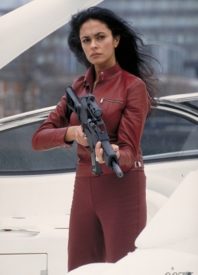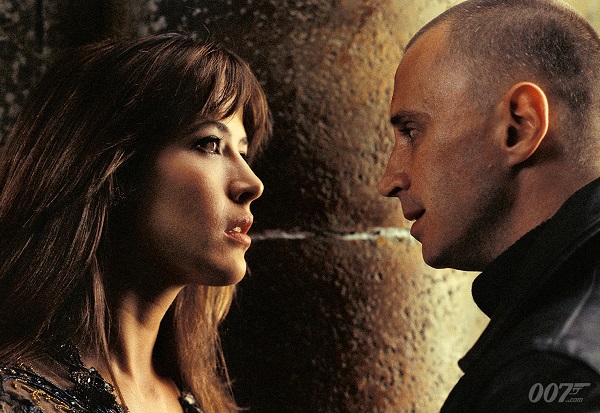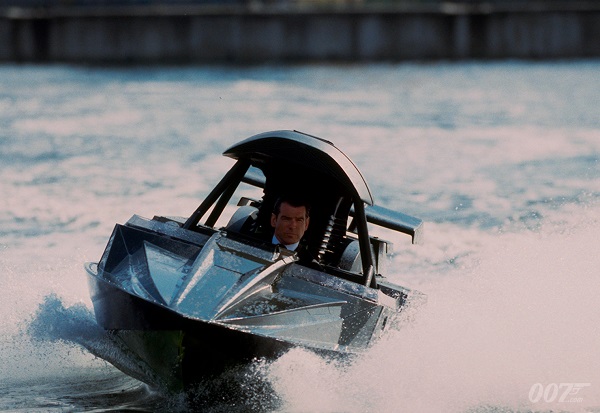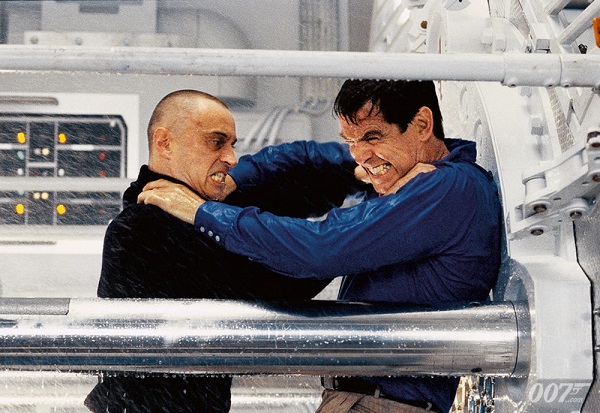
“Always have an escape plan.”
Pierce Brosnan returned a third time as Ian Fleming’s James Bond 007 in The World Is Not Enough. They took that title from Bond’s own coat of arms, as revealed in On Her Majesty’s Secret Service). Despite a solid story idea, and mostly exceptional casting, one glaring error makes The World Is Not Enough feel like a bit of a stumble. It was the first time I walked out of a 007 film because its ending was summarily unimpressive.
Producers Barbara Broccoli and Micheal G. Wilson turned to Neal Purvis and Robert Wade to develop a story idea. One that centered around the untapped oil resources in the Caspian Sea. They built the concept of one person working to monopolize it all for themselves. This led to the development of an intricate story, with layered (as far as a Bond film goes) characters specifically those of the villains of the piece. There’s Renard (played adeptly by Robert Carlyle), a dying man who can’t feel pain. It also had an oil heiress Elektra King (Sophie Marceau). She’s a kidnap victim who then fell in love with her kidnapper.
The production turned to Michael Apted to take the director’s chair. An unusual choice, Apted was previously best known for his work with Jodie Foster in Nell. He also directed Sigourney Weaver in Gorillas In The Mist. Neither of those films featured big action set pieces, but did feature strong female characters. That was something the series was intent on bringing to the fore. With Apted aboard, he turned to another 007 scribe, Bruce Fierstein to help punch up the script.
Lindy Hemming returned as Costume Designer, while Peter Lamont continued his role as Production Designer. Famed stunt artist Vic Armstrong served as the Second Unit Director, while Adrian Biddle came aboard as the Director of Photography with Jim Clark cutting the film.
There are many joining Brosnan, Marceau and Carlyle in front of the camera. One of them is the horrible casting choice that is Denise Richards as nuclear scientist Christmas Jones. Balancing that out are Judi Dench as M, Samantha Bond as Moneypenny, and Micheal Kitchen returning as Tanner. It marked Desmond Llewelyn’s final appearance of Q, as he died in a car accident shortly after the film’s release. It marked the first appearance of his heir apparent, R played by John Cleese. Robbie Coltrane, Colin Salmon, and Serena Scott Thomas also appeared in the film.
The film features some great stunt work, including an exciting sequence shot on the Thames featuring the Q-boat, which at its climax features a drop from a hot air balloon. There’s also a para-hawk/ski set piece, both of which stand out as high points in the film. While not quite overladen with gadgets yet, we know that 007’s new BMW Z8 is fully loaded. Sadly, we (intentionally) never get to see a payoff for it.
David Arnold delivers another John Barry-esque score, and worked with Shirley Manson and Garbage to compose the title song, which consequently recurs as a motif throughout the film itself. And following the longest pre-credit sequence to date, Daniel Kleinman gives us another set of titles.
Filming took place at Pinewood Studios, the first 007 film to use the studio as a production base since The Living Daylights. Apted and Biddle shot around the globe including locations in Spain, France, Azerbaijan, Kazakhstan, Turkey. They also shot areas around the UK including Scotland, and Apted and Biddle know how to make it all look stunningly beautiful, allowing Brosnan’s Bond to move through it with style and ease.
Brosnan looks great and has settled into the role now, and is arguably too comfortable, as nothing seems to faze the character, he’s completely unflappable. He fixes his tie while submerged. It’s an over the top touch that still elicits a laugh. And despite an injury at the beginning of the film, the character is reaching a state of indestructibility. Is there a level above super-spy? Cause this is where the character is at this point, a far cry from Fleming’s original creation, but still recognisable nonetheless.
Both M and Elektra prove to be deeper characters than most female characters featured in a Bond film today. And M’s expanded role in the film only serves to benefit what is a run of the mill adventure for 007. It doesn’t push the franchise forward in a new way, and instead is, sadly, just another entry in the series. That doesn’t mean there aren’t enjoyable sequences, I love the first clash between Renard and Bond, and the action sequence it launches. And the effects work for the submarine, models, miniature and computer generated images is solid.
There are a lot of gadgets, the BMW is tricked out, Bond’s Omega watch has lots of fun attachments. There’s the Q-Boat, and of course the snazzy specs. In fact the film has everything you would expect from a 007 film, a franchise with gorgeous locations. There are the gadgets, and a rousing score, but at this point, nineteen films in, it’s almost routine. And I don’t want to say predictable, but you know by film’s end there will be explosions aplenty. There are also some great stunts, some (half) witty lines and the Bond character won’t really have grown at all.
The film had a successful box office, and Brosnan is fantastic in the role. But it’s obvious that the series needs to have a bit of a shake-up if it is going to continue to move forward and thrive. It needs to embrace strongly written characters across the board. The Brosnan era did do something right, in terms of shaking things up, stronger female characters played by great actors. And the producers brought in different directors to bring their own take on 007 (within parameters) to the screen.
Time came to promoting the film in advance of its 19 November, 1999 North American premiere date. It was the last 007 of the 20th century. An advance campaign featuring a ‘flame girl’ was created by Randi Braun, Diane Reynolds and Vincent Patterson. It became almost emblematic of the entire series, and became instantly iconic. The release poster for the US and the UK were different. Brian Bysouth oversaw the flame dominated UK Quad, with photography by Nigel Parry, Keith Hamshere and Jay Maidment. The US version, is sleeker in design, but loses the flame motif. It featured work by Diane Reynolds, Mark Belin, Daman Kidwell, Randi Braun, Parry, Hamshere, and Maidment. There’s a delightful Italian advance one sheet by designer Gavino Sanna about having a good reason not to see the new James Bond film.
I was a little stunned by how much I didn’t enjoy here as I walked out of the theater. When the credits rolled, I was reminded that how much I did or didn’t enjoy it the first time through might not matter. That 007 would endure, because James Bond Will Return, for his 20th film!
Thanks to my personal Q Branch, DK Canada’s extensive 007 library. That includes Bond By Design: The Art of the James Bond Films, James Bond: 50 Years of Posters, and The James Bond Encyclopedia.
- Release Date: 11/19/1999




